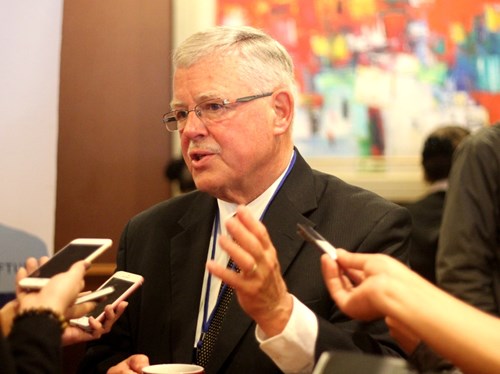Following is the full text of Thayer’s article.
“Australia and Vietnam established diplomatic relations in 1973 after negotiations were concluded in Paris that resulted in an Agreement to End the War and Restore the Peace in Vietnam. Bilateral relations have been continually developed with two major turning points.
The first major turning point was reached in 2009 during the visit to Canberra by Nong Duc Manh, Secretary General of the Vietnam Communist Party. On September 7, Deputy Prime Ministers Julia Gillard and Pham Gia Khiem signed a joint statement raising bilateral relations to a comprehensive partnership.
    |
 |
|
Aussie Prof Carlyle A. Thayer (Photo: dantri.com.vn) |
This partnership was based on six major areas of mutual co-operation: political and public policy exchanges; economic and trade relations; development assistance and technical cooperation; defense and security; people-to-people links; and global and regional issues. The comprehensive partnership was implemented through a three-year Plan of Action (2010-13).
The second turning point in bilateral relations took place in March 2015 during the visit to Canberra by Prime Minister Nguyen Tan Dung. Senior ministers from both sides signed the Declaration on Enhancing the Australia-Vietnam Comprehensive Partnership. This declaration identified five major areas of cooperation: deepening bilateral ties; regional and international; economic growth, trade and industry development; development assistance; defense, law enforcement and security ties.
“The significance of the enhanced comprehensive partnership lies in the recognition by Australia and Vietnam that there is a growing convergence of interests and outlook between them. For example, the preamble to the Declaration asserted: ‘Vietnam and Australia have built strong relations on the basis of mutual respect and interest. The relationship contributes to the peace, stability, cooperation and development of each country as well as the region and the world.’
Both Vietnam and Australia share a mutual interest in maintaining regional security, stability and economic development based on respect for sovereignty and international law. Both are also in agreement of the importance of multilateral institutions such as the Association of Southeast Asian Nations (ASEAN), Asia-Pacific Economic Cooperation (APEC), and the East Asia Summit (EAS).
“Vietnam and Australia also have convergent views on the importance of long-term global and regional economic integration based on trade and investment liberalization. For example, both countries participated in efforts to negotiate the Trans-Pacific Partnership Agreement or TPP. When the President Trump withdrew from the TPP, both Vietnam and Australia participated in successful negotiations for a Comprehensive and Progressive Agreement for Trans-Pacific Partnership Agreement or TPP-11.
“Little noticed at the time, in March 2015 the prime ministers of Vietnam and Australia agreed to establish a strategic partnership in the future.
Currently Vietnam has eleven strategic partnerships, including four of the five members of the United Nations Security Council as well as Japan and India. The Vietnam- Australia strategic partnership will lead to more regular exchanges between the top leadership and better coordination to deal with the many challenges to economic development, transnational issues, and peace and security in the region and globally.
Both Vietnam and Australia share convergent views on the East Sea territorial dispute. They both agree on the peaceful settlement of disputes, without the use or threat of force, on the basis of international law including the 1982 United Nations Convention on the Law of the Sea. Both are in agreement that ASEAN and China should negotiate a binding Code of Conduct in the South China Sea. Both support freedom of navigation and aviation. Both countries call on all parties to exercise restraint and refrain from actions that could increase tensions in the region. Both countries agree on the urgent need to conclude a code of conduct for the South China Sea.
No better example of cooperation to contribute to global peace and security can be provided than Vietnam’s commitment to deploy a Level 2 Field Grade Hospital to the United Nations Mission in South Sudan and Australia’s offer to fly the Vietnamese peacekeepers in Royal Australian Air Force Hercules transport aircraft.
The time is now ripe to raise bilateral relations to a strategic partnership on the occasion of the visit by Prime Minister Nguyen Xuan Phuc to Canberra from March 14-15 to mark the forty-fifth anniversary of diplomatic relations. This will mark the third major turning point in bilateral relations.”
Source: VNA